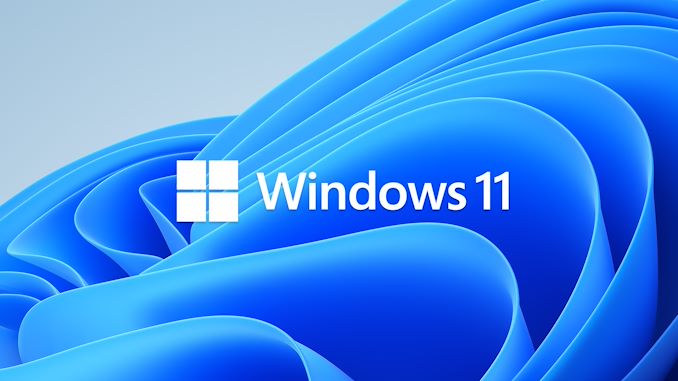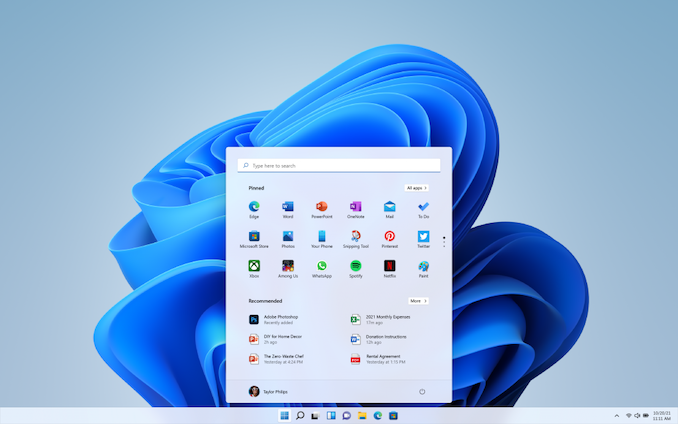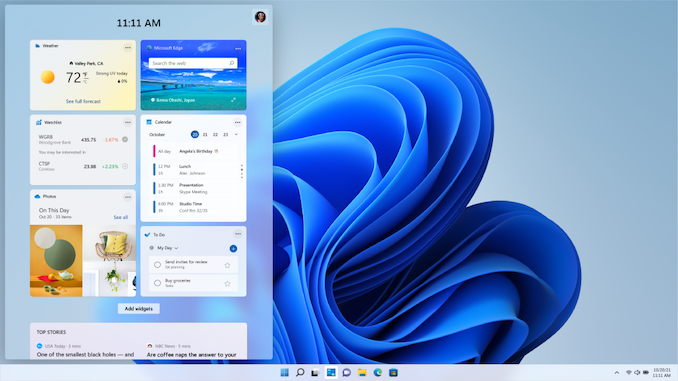What to Expect with Windows 11: A Day One Hands-On
by Brett Howse on October 4, 2021 4:00 PM EST- Posted in
- Software
- Operating Systems
- Windows
- Microsoft
- Windows 11

Tomorrow, Microsoft is officially launching Windows 11, the next installment of their operating system which underpins the majority of PCs in use today. Windows 10 has an install base of over 1 billion devices, and Windows 11 comes into existence in a much different place than its predecessor. After the much-maligned Windows 8 there was a sense of urgency and necessity which ushered Windows 10 into the world. Windows 11, on the other hand, comes into a market where most people are happy with Windows 10. So it raises the question: Why now?
When Windows 10 launched, it was said to be the final version of Windows, and future updates would be additive to Windows 10, rather than a new version number. But that was six years ago, and times have changed, as has the management and ownership of the Windows development team at Microsoft. For better or worse, the company has deemed that now is a good time to do a clean break again, with all of the animosity and angst that will bring to a good portion of their customers, especially businesses who may still be in the process of migrating to Windows 10.
The question is why now? What is new? Why is Microsoft choosing this moment to switch from the very successful Windows 10 and implement another upgrade cycle? Some of these questions can be answered, but others will take time.
Refreshed User Interface
The immediate change that everyone will notice is that Microsoft has completely revamped the user interface for Windows 11. They have apparently gotten tired of their obsession with flat, stark interfaces and moved to a much more colorful and expressive theme.
There are also major changes to the Start Menu and the taskbar. The Start Menu has ditched the live tile idea. Although a good idea on the now defunct Windows Phone platform, live tiles never really worked well on the desktop and could make it more difficult to find the application you were looking for since the icon would change. Instead, the Start Menu goes back to basic app icons, but now with the Start Menu, by default, centered in the middle of the display.
Live tiles have been replaced with Widgets and can be accessed via a Widget icon on the taskbar. Currently the selection of Widgets is only Microsoft ones, and it will be interesting to see if this expands over time.
Tablet Mode is now gone as well, so if you liked to use Windows 10 in its more touch-friendly mode, you will likely be disappointed.
The taskbar also moves from a left-justified look to being centered, and when more applications are opened, the icons already on the task bar will shift to the left to keep things centered. Apps can also no longer customize areas of the taskbar.
The taskbar can also no longer be moved from the bottom of the display if you were someone who liked to slide it to one of the other sides of the screen, which will likely disappoint a lot of people. When your user base is over 1 billion, if even only 1% of users used a feature, that’s still 10 million people that used that feature.
Overall, the new user interface is clean, colorful, and breathes some new life into what had become a bit stale in Windows 10. Functionally, it is not drastically different than Windows 10, although moving the Start Menu from the bottom left corner where it has been since Windows was first Windows is a bold change. The loss of Live Tiles seems like a downgrade in functionality, but it does make the interface more consistent and easier to access the applications you are looking for, with widgets hoping to take up the slack. But, there is a surprising amount of customization and features that are being dropped.












95 Comments
View All Comments
Peter2k - Tuesday, October 5, 2021 - link
Gotta remember the Windows 10 credo back then"Windows everywhere"
Means PC, XBOX and phones
Since that failed I guess the new direction is to clamp down on security
While you could have all the security on 10, 11 is enforcing it
Guess they try to go after big business bucks
I'm on a first Gen Ryzen, not gonna upgrade just because I could force it
For what really
It looks a bit prettier, and sounds a bit prettier
That isn't weigh for me as a private person to upgrade the OS, and especially not to build a new rig
Personally I think the getting "Windows crammed into everything anywhere " isn't this generations motto at all
It's more, take it or leave it
Also keep in mind Windows terrible history/cycle
One OS is great, next one is trash
Hasn't been broken yet
While 11 might not be trash, it could very well be under performing for adoption
griffin_short - Tuesday, October 5, 2021 - link
Exactly. Just release a massive UI overhaul for Windows 10 rather than launching a whole new OS.dullard - Tuesday, October 5, 2021 - link
EcoQoS and enhanced PowerThrottling API are why. Just about every Windows 11 app was recompiled for lower power usage compared to Windows 10, this will be especially true when Alder Lake comes out.croc - Tuesday, October 5, 2021 - link
They REALLY NEED to get a better typeface....The current one is too 'light' for weaker eyes to not have to strain, causing some to have headaches after LONG usage times.The loss of Win 10's start-up 'groups' can be solved by making folders and copying (or creating) shortcuts inside. For instance, a folder called 'Office' with the various shortcuts inside.
Really, this is more about new paint as it is about a better OS
beginner99 - Tuesday, October 5, 2021 - link
The fact you can't change the taskbar location is just one small things about how the taskbar is now almost useless and productivity will be heavily impacted.Like the claimed improved multi-monitor support but yet the new taskbar only show the clock on the primary monitor which when in full screen-mode means no clock visible. It's a 1 step forward 2-steps back situation really.
voicequal - Tuesday, October 5, 2021 - link
I'm guessing they'll add the taskbar location option, since almost every Win11 article seems to mention it as a deficiency. This seem like a minimum viable product. Time will tell how fast features will be added to fill in the rough spots.damianrobertjones - Tuesday, October 5, 2021 - link
Installs Windows 11 onto a Surface Book. Installs applications while changing a few configuration options. launches applications. Continues as normal.No issues here. Then again, I'm not LOOKING for a reason to moan and complain. It still does what it should do (mostly).
incanter - Tuesday, October 5, 2021 - link
If your Surface Book had 16:9 screen, you might be more tolerant to "moans and complaints" about inability to move taskbar to the side of the screen, then again, maybe you do not have to work with the structured text the whole day long...haplo602 - Tuesday, October 5, 2021 - link
Hmm ... not being able to move the task bar is a big negative for me ... I may be one of the few people that used that feature, but for years (since windows 2k) my desktop layout was centered around having the taskbar on the right side of the screen.I hope somebody will program an extension that will allow this.
incanter - Tuesday, October 5, 2021 - link
You are, definitely, not alone -- a lot of people who work with the structured text (e.g code) value every pixel of the vertical real estate. This said, it is certainly less of an issue on Microsoft devices with 3:2 screen aspect ratio...